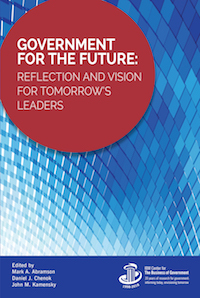
Visions of Government Reform in 2040: Networked Government

In the IBM Center’s new book, Government For The Future: Reflection and Vision for Tomorrow’ Leaders, part two of the book looks twenty years ahead offering perspectives on the future. This contribution is the next in a multi-part series, Networked Government: Managing Data, Knowledge, and Services, by Lori Gordon.
Gordon’s chapter envisions that “by 2040, the federal government will disband its traditional agency structure and will establish networked teams to perform government work. These teams crowdsource the priority topics or challenges of the moment, then bring cross-disciplinary talent, research, and ideas to develop solutions that they tailor to each individual citizen.”
While this initially may seem fanciful, the seeds of how to organize in this radically different fashion already exists today. A recent article in the Harvard Business Review, The End of Bureaucracy,” by Gary Hamel and Michele Zanini describe how a 75,000 person, global household appliance maker has applied similar principles to its operation to make it more innovative and customer-facing. In their case study, the Chinese appliance maker Haier has radically reorganized from a monolithic business to a set of 4,000 microenterprises comprised of 10-15 employees each. In this new arrangement, the microenterprises are grouped into different varieties, such as market-facing, new product development, design, manufacturing, etc.
Similarly, Lori Gordon writes that by 2040, given rapid advances in technology, the federal government will radically improve its ability to engage and involve more of the American public in its policy and administrative processes. Through a new organizational structure less focused on the institution and more focused on communities of interest and a redistribution of responsibilities, the re-engineered government will be more accountable to, and reflective of, its constituency—and more nimble and able to shift priorities, policies, and programs in strategic directions.
To organize this new redistribution of decision making and responsibilities, by 2040 the government will establish a new managerial class that redesigns how data, knowledge, and services flow across digital pathways and provide an evolving variety of service offerings that reflect society’s changing needs and requirements.
Data Managers will oversee a virtual government workforce comprised of teams that aggregate data in digital workspaces and process it almost instantaneously via the eighth-generation wireless network. Reaching into the technology and scientific communities, Data Managers will peel back how virtual reality, augmented reality, machine learning, and the Internet of Things (IoT) are crunching volumes of unstructured data, and how they can better amass even larger amounts of it.
The cross-agency network of data managers will reimagine and reorganize data sensing and feed- back loops so that the government can gain rich insights from citizens to inform knowledge-driven decisions. Without needing to procure costly studies or to requisition surveys, government will have instantaneous citizen input on issues that range from early childhood services to flood management to space security.
Knowledge Integration Managers will bridge knowledge, methods, data, and investigative communities. They will serve as catalysts and conveners, bringing together disciplines and experts from different domains to pursue shared research challenges. They will also deconflict or synchronize similar or redundant government initiatives.
The large governmental data sets developed by Data Managers will be analyzed by Knowledge Integration Teams which will used crowdsourced data to build heatmaps of high-priority issues. This will trigger government processes to reallocate resources and develop responsive solutions.
Customized Services Managers will use the data aggregated by Data Teams and analyzed by Knowledge Integration Teams to provide tailored resources and services to constituents at the community level. This will include everything from prescribing medicine to veterans to providing emergency kits to disaster victims. These virtual cross-discipline networked teams will develop tailored services and solutions that replace government departments and agencies by 2040.
Operationally, these teams will set a standard for how the rest of government begins to operate. The process will work like this: as Customized Service Teams solve challenges, they will be rewarded with more complex, challenging issues. Once they resolve these challenges, they will become eligible for bonus pay. This will incentivize them to prioritize tackling and resolving the toughest challenges, and to encourage further constituent feedback and response.
In sum, government by 2040 will reshape its structure, its distribution of responsibilities, and its technology investment to engage the American public more directly. This newly re-engineered, networked government will be more accountable to and reflective of citizens, and much better able to shift priorities, policies, and programs in strategic directions.



